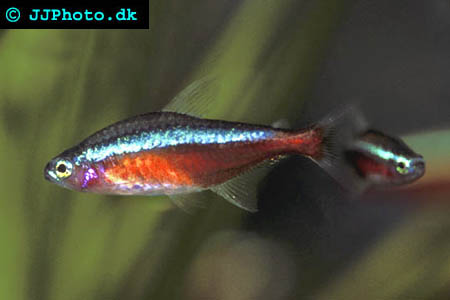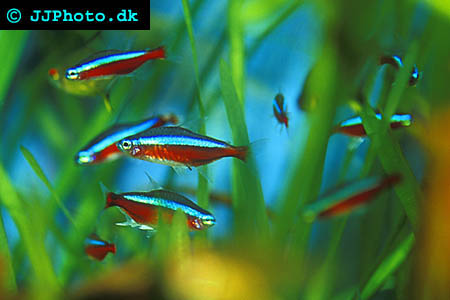Cardinal Tetra Fish
Just like many other commonly kept tetra fishes, the Cardinal tetra (Paracheirodon axelrodi) is a small South American egg-laying freshwater fish that belongs to the family Characidae in the order Characiformes. The Neon tetra is one of the most frequently kept fish species among aquarists, and is especially popular among beginners. The Cardinal tetra is not as commonly kept as the Neon tetra, but it is still found in numerous freshwater aquariums all over the world. The Cardinal tetra is often confused with the Neon tetra, and the Cardinal tetra is sometimes referred to as “red neon tetra”. Both species are decorated with a characteristic iridescent blue line that bisects the body. You can easily distinguish a Cardinal tetra from a Neon tetra by looking at the lateral red stripe that is found under this line. If the red stripe extends no longer than roughly halfway to the nose, you are looking at a Neon tetra. If the red stripe is longer, the fish is a Cardinal tetra. The name Cardinal tetra refers to this red coloration, since it resembles the vividly red robes worm by cardinals. The fish has gotten its scientific name, Paracheirodon axelrodi, in honour of the famous ichthyologist Herbert Axelrod.
Unlike the Neon tetra, the Cardinal tetra is considered hard to breed in aquariums and this is one of the reasons behind its relative scarcity in the aquarium trade. A majority of the Cardinal tetras offered in fish stores have been wild caught. Wild Cardinal tetra is found in the upper Orinoco and Negro rivers on the South American continent. The Cardinal tetra is not considered an endangered species and it is very prolific in the wild. Its natural life span is no longer than a year, and it will therefore reproduce within a year after being hatched. It is however possible for a Cardinal tetra to survive for many years in an aquarium without any predators.
The Cardinal tetra will grow up to 3-5 centimetres (1.25-2 inches) long and does not require a large aquarium. Even a small 5 gallon aquarium can comfortably house a Cardinal tetra. Since the Cardinal tetra is a peaceful creature, it is often found in community aquariums. It is a top and mid dweller that will accept most food types, including flake food.
 |
The conditions in the aquarium should ideally resemble those found in the South American river in which your Cardinal tetra lived before it was captured. The Orinoco and Negro rivers have extremely soft water with a low pH, and the water temperature is 73-81 degrees Fahrenheit (23-27 degrees Celsius) or even higher. Keep the dGH below 4 and the pH between 4.6 and 6.2. You can adapt your Cardinal tetra to alkaline and hard water, but this can make the Cardinal tetra more delicate and sensitive. Regardless of pH and hardiness, your Cardinal tetra will be sensitive to high levels of soluble waste, especially nitrate. Regular water changes are of course imperative. Some people think that the Cardinal tetra is unsuitable for beginners, but as long as you are ready to perform frequent water changes and devote some energy to your aquarium you can have Cardinal tetras even in your first aquarium.
Your Cardinal tetra will appreciate a densely planted aquarium with some open swimming space in the centre. Floating plants that dims the light a bit is recommended. Keeping a single Cardinal tetra is not a good idea, since the fish will feel much better in a school of at least 10 individuals. A school of these small but colourful fishes will also look better than just one single and shy Cardinal tetra.
 |
Aquarists who wish to spawn their Cardinal tetras should provide them with live food. As mentioned above, breeding Cardinal tetra in captivity is hard and even if you manage to get your fish into spawning condition the fry are very sensitive and high death rates are common. This is an egg-laying species that prefers fine leaved plants when breeding. A female Cardinal tetra can release more than 500 eggs during one spawning. The adult fish can eat eggs as well as fry, and keeping them in the same aquarium is therefore hazardous. You must provide your fry with very small food, since Cardinal tetra fry are tiny.


No comments:
Post a Comment